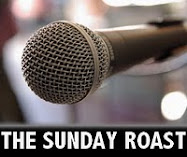So last week, I went to play tennis with three of my friends -- Matt, Martin, and Ray. Those guys have been playing regularly for several years and are therefore much better than I am. If we were the Beatles, for example, the three of them would be John, Paul and George while I would be Ringo. Actually, that's giving me too much credit. Ringo had his moments, and when hey-hey-hey came to yeah-yeah-yeah, he was a pretty respectable drummer. I guess I'd be the guy who got kicked out of the Beatles right before they became famous because he didn't want to get the haircut or something. On a related note, if you or someone you know has a tendency to let their analogies spin wildly out of control, contact the Convoluted Analogy Hotline at 1-800-COW-IS-TO-CALF. Operators are standing by.
We normally play doubles, first of all because there's four of us and the math works out conveniently, and also because with two players on a side, there's less running around to do. For my part, I pretty much stand in one place hitting the balls that come directly to me while my teammate Matt runs around like a maniac getting everything else. He's younger and fitter than I am which, while not saying much, is definitely a factor in devising our game plan. Besides, I'm a little rusty on basic tennis strategy, so I'm never quite sure where on the court I'm supposed to be. A lot of the time, and I only wish I were exaggerating here, it looks like I'm playing dodgeball.
In formal tennis tournaments like Wimbledon, the U.S. Open, or the Greater Pawtucket Regional Tennis Classic, a team of linesmen (or lineswomen) position themselves at various locations around the perimeter of the court to determine if the players' shots are in or out of bounds. If a ball hits "inside" the line or "on" the line, the ball is considered to be "in." If a shot, for whatever reason, goes screaming into the stands and caroms off the skull of a guy returning to his seat with a handful of churros, the ball is called "out." There is another umpire who sits in a tall chair at center court called, coincidentally enough, the "chair umpire." His (or her) primary responsibility, as far as I can tell, is to have profanities screamed at him by John McEnroe.
In a casual match, such as the one Matt, Martin, Ray and I were engaging in last week, players make the call for their opponents' shots. You'd think the temptation to cheat would be overwhelming, but in our case it turned out to be just the opposite. We're all friends, of course, and I could tell that Martin and Ray were giving me the benefit of the doubt on a lot of their line calls. It's almost as if they were thinking, You know, Chris hasn't played in a while and he sure ran a long way to get to the ball on that one. What's a couple inches or so? "IN! NICE SHOT!"
Even so, Matt and I lost the first set 7-5.
Which brings us to the topic of keeping score.
The scoring system in tennis is so complicated and random that it makes a bowling scoresheet seem like child's play. A child playing with a computer, perhaps, but still a child. To make things as simple as possible -- remember this is relative -- we'll work backwards.
The winner of a tennis match is the first player (or doubles pair) to win three sets. For women, it's best two out of three because women usually have better things to do than spend four or five hours chasing fuzzy yellow balls around. Win the most sets, you win the match. This is the easy part.
To win a set, you have to be the first to win six games (we'll talk about "games" in a minute), by a margin of two. For example, a set cannot end by a score of six games to five. When it gets to that point, you play another game and either the set is won 7-5, or it's tied at six and you play what's known as a "tiebreaker." The tiebreaker is decided when one player (or team) reaches seven points, again by a margin of two. Tiebreakers have been known to last several weeks and end with a score of 140-138.
Believe it or not, this is still the easy part.
To win a game, you have to win four points, again by the ever-present margin of two. In most sports, like hockey and baseball for example, the scoring is linear. One, two, three, four . . . you get the idea. In tennis, however, you do not start with "zero." You start with "love." As sweet as that sounds, it doesn't make a lot of sense. When you score your first point, you have 15. Your second point takes you to 30. So here's a quick quiz. What do you have when you get your third point?
Did you say 45?
Wrong.
After your third point, you have 40. This has never been explained to anyone without their head exploding.
When the game is tied at 40, this is called "deuce." Then someone has to win two points in a row to win the game. There's more to explain, like the definitions of "ad-in" and "ad-out" but it would just bore you into oblivion if that hasn't already happened.
Back to our doubles match.
After losing the first set, Matt and I rebounded and took the second one six games to four. Halfway through the set, I started to feel like I was dragging a Steinway grand piano through wet cement but we persevered through my agony.
The highlight of the match was when one of my errant serves drilled Matt in the back of the head. But he didn't even get mad.
This is because he knew there was no way I would've hit his head if I'd actually been aiming at it.
d























